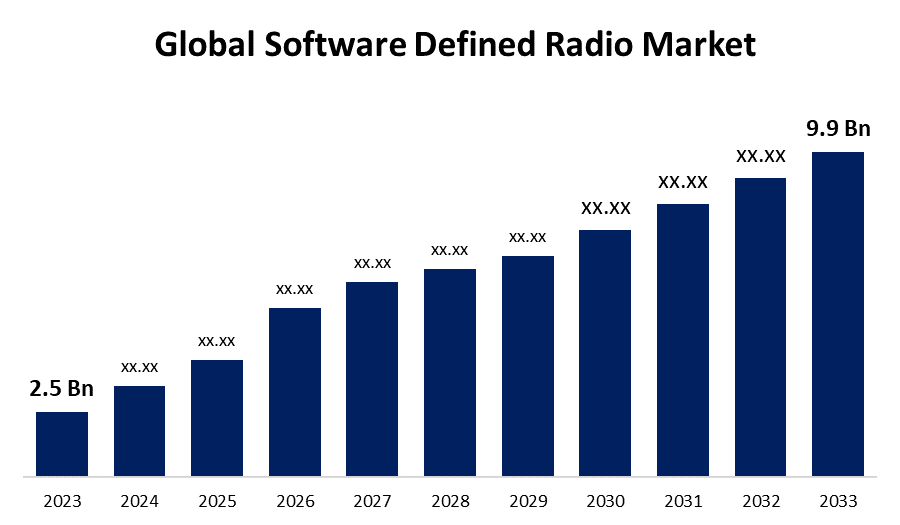Global Software Defined Radio Market Size To worth USD 9.9 billion by 2033 | CAGR of 14.75%
Category: Aerospace & DefenseGlobal Software Defined Radio Market worth $9.9 billion by 2033
According to a research report published by Spherical Insights & Consulting, The Global Software Defined Radio Market Size to grow from USD 2.5 billion in 2023 to USD 9.9 billion by 2033, at a Compound Annual Growth Rate (CAGR) of 14.75% during the forecast period.

Get more details on this report -
Browse key industry insights spread across 240 pages with 110 Market data tables and figures & charts from the report on the "Global Software Defined Radio Market Size, Share, and COVID-19 Impact Analysis, By Type (General Purpose Radio, Joint Tactical Radio System, Cognitive Radio, TETRA), By Component (Hardware, Software), By Platform (Ground, Naval), and By Region (North America, Europe, Asia-Pacific, Latin America, Middle East, and Africa), Analysis and Forecast 2023 - 2033." Get Detailed Report Description Here:https://www.sphericalinsights.com/reports/software-defined-radio-market
The Software Defined Radio (SDR) market is experiencing robust growth, driven by the increasing need for adaptable and interoperable communication systems across sectors like defense, aerospace, telecommunications, and public safety. SDR technology allows for the flexible reconfiguration of radio functions through software, minimizing hardware reliance and enhancing adaptability. The growing use of SDRs in military operations for secure communications, combined with advancements in cognitive radio and AI integration, is accelerating market growth. Furthermore, the expansion of 5G networks and IoT connectivity is further fueling demand. North America dominates the market due to substantial defense investments, while Asia-Pacific is rapidly growing, driven by expanding telecom infrastructure. Despite challenges such as high initial costs and cybersecurity concerns, ongoing technological progress and regulatory support are expected to drive continued market adoption.
Software Defined Radio Market Value Chain Analysis
The Software Defined Radio (SDR) market value chain consists of several stages, starting with raw material and component suppliers who provide critical hardware such as processors, FPGAs, RF front-ends, and antennas. SDR manufacturers and developers then integrate these components with software-defined functionalities to ensure flexibility and performance. Software providers play a key role by creating waveforms, protocols, and security features for smooth operation. System integrators customize SDR solutions for sectors like defense, telecommunications, and public safety. Distributors and service providers facilitate market expansion by offering deployment, maintenance, and updates. Finally, end-users, including military agencies, telecom operators, and emergency services, deploy SDRs for secure and adaptable communication. Ongoing innovation and adherence to regulatory standards are vital to the growth and evolution of this value chain.
Software Defined Radio Market Opportunity Analysis
The Software Defined Radio (SDR) market offers significant growth potential, driven by advancements in wireless communication, defense modernization, and the expansion of 5G and IoT networks. The increasing demand for secure, flexible, and interoperable communication systems in military and public safety sectors is driving market expansion. Emerging markets, particularly in Asia-Pacific, present opportunities due to growing defense budgets and telecom infrastructure development. The incorporation of AI and machine learning into SDRs improves spectrum efficiency and cognitive radio capabilities, creating new opportunities. Additionally, commercial applications such as satellite communications, autonomous vehicles, and smart grid networks are boosting SDR adoption. While challenges like high upfront costs and cybersecurity concerns exist, ongoing technological innovations and regulatory support are expected to propel continued market growth.
The rapid progress of wireless communication technologies is a major driver behind the growth of the Software Defined Radio (SDR) market. The increasing need for flexible, reconfigurable, and software-based communication systems is accelerating SDR adoption across defense, telecommunications, and public safety sectors. The growth of 5G networks, IoT connectivity, and satellite communications further expands market opportunities. SDRs offer seamless interoperability, enhanced spectrum efficiency, and secure communication, making them vital for modern infrastructure. Emerging technologies such as AI-powered cognitive radios and cloud-based SDR solutions are reshaping the industry. Additionally, rising defense investments and the demand for secure tactical communications are boosting market growth. Despite challenges like cybersecurity risks and high deployment costs, continuous innovation and regulatory support are expected to sustain the growth of the SDR market.
The Software Defined Radio (SDR) market faces several challenges despite its increasing adoption. High upfront costs for development, deployment, and maintenance present a significant hurdle, particularly for small and medium-sized enterprises. Cybersecurity risks are also a concern, as SDRs depend on software-based processing, making them susceptible to hacking and signal interference. Integrating SDRs with existing communication infrastructure and legacy systems can be complex, slowing down adoption. Furthermore, regulatory and spectrum allocation issues pose challenges for deploying SDRs across various regions. The demand for skilled professionals to manage SDR systems adds to operational difficulties. Additionally, power consumption and latency issues in real-time applications can affect performance. Overcoming these challenges through technological advancements and regulatory support will be vital for the continued growth of the SDR market.
Insights by Component
The hardware segment accounted for the largest market share over the forecast period 2023 to 2033. Key components such as field-programmable gate arrays (FPGAs), digital signal processors (DSPs), RF front-ends, and antennas are advancing to accommodate higher frequencies and greater bandwidths. The growing adoption of SDRs in sectors like defense, aerospace, and commercial industries, including 5G networks and IoT, is driving increased demand for hardware. Additionally, advancements in AI and machine learning are improving the efficiency and adaptability of SDR hardware. However, challenges such as high development costs and power consumption remain. Despite these obstacles, ongoing technological innovations and rising investments in next-generation SDR platforms are expected to fuel continuous growth in the hardware segment.
Insights by Type
The joint tactical radio system segment accounted for the largest market share over the forecast period 2023 to 2033. JTRS provides secure, flexible, and interoperable communication solutions for defense forces, enabling them to adapt to evolving battlefield conditions. With increasing investments in defense and security, especially from the U.S. Department of Defense, the demand for JTRS-equipped SDR solutions is rising. Its ability to integrate diverse communication systems and support multiple frequency bands improves the efficiency of military operations. Furthermore, advancements in cognitive radio technologies and spectrum management are enhancing JTRS performance. Although challenges such as high costs and integration complexities with legacy systems exist, the growing emphasis on modernizing military communications is expected to drive continued growth in the JTRS segment.
Insights by Platform
The ground segment accounted for the largest market share over the forecast period 2023 to 2033. Ground-based SDR systems are crucial for applications such as satellite communication, border surveillance, and public safety. The demand for high-performance, adaptable radio solutions capable of operating across various frequency bands and environments is driving the rapid adoption of these systems. Furthermore, the integration of SDRs in ground stations for 5G networks, IoT infrastructure, and disaster response is broadening their application. Innovations in cognitive radio and spectrum efficiency are further enhancing the functionality of ground-based SDR systems. Although challenges like high initial costs and integration with existing communication infrastructure remain, these issues are being addressed through continuous technological advancements and government investments, particularly in defense and emergency services.
Insights by Region

Get more details on this report -
North America is anticipated to dominate the Software Defined Radio Market from 2023 to 2033. The U.S. is at the forefront of the region, driven by substantial military spending on secure and flexible communication systems for tactical operations. The increasing adoption of SDRs in public safety, aerospace, and commercial sectors further accelerates market growth. The expansion of 5G networks and IoT connectivity is also driving demand for SDR technology in telecommunications and enterprise industries. Moreover, research and development efforts by key industry players and government organizations like the Department of Defense and NASA are fostering continuous innovation. Despite challenges such as cybersecurity concerns and regulatory complexities, ongoing investments and technological advancements are expected to maintain North America's leadership in the SDR market.
Asia Pacific is witnessing the fastest market growth between 2023 to 2033. China, India, Japan, and South Korea are making significant investments in SDRs to modernize their military, enhance secure tactical communication, and support public safety applications. The ongoing rollout of 5G networks and the widespread adoption of IoT are further boosting demand for SDRs in commercial sectors. Additionally, increasing research efforts and government support for domestic SDR development create more opportunities in the market. However, challenges such as regulatory compliance, spectrum allocation issues, and cybersecurity concerns remain. Despite these obstacles, Asia-Pacific continues to be a promising market, with sustained investments in defense, telecommunications, and aerospace expected to drive long-term adoption and technological advancements in the SDR sector.
Recent Market Developments
- In October 2024, BAE Systems plc received a contract from the U.S. Army worth up to USD 460 million to supply multi-mode aviation radio sets, which are essential for enhancing communication capabilities in military operations.
Major players in the market
- BAE Systems (US)
- L3Harris Technologies, Inc (US)
- Northrop Grumman Corporation (US)
- Thales (France)
- Elbit Systems Ltd. (Israel)
- General Dynamics Corporation (US)
- Raytheon Technologies Corporation (US)
- Leonardo Company
Market Segmentation
This study forecasts revenue at global, regional, and country levels from 2023 to 2033.
Software Defined Radio Market, Type Analysis
- General Purpose Radio
- Joint Tactical Radio System
- Cognitive Radio
- TETRA
Software Defined Radio Market, Component Analysis
- Hardware
- Software
Software Defined Radio Market, Platform Analysis
- Ground
- Naval
Software Defined Radio Market, Regional Analysis
- North America
- US
- Canada
- Mexico
- Europe
- Germany
- Uk
- France
- Italy
- Spain
- Russia
- Rest of Europe
- Asia Pacific
- China
- Japan
- India
- South Korea
- Australia
- Rest of Asia Pacific
- South America
- Brazil
- Argentina
- Rest of South America
- Middle East & Africa
- UAE
- Saudi Arabia
- Qatar
- South Africa
- Rest of the Middle East & Africa
About the Spherical Insights & Consulting
Spherical Insights & Consulting is a market research and consulting firm which provides actionable market research study, quantitative forecasting and trends analysis provides forward-looking insight especially designed for decision makers and aids ROI.
Which is catering to different industry such as financial sectors, industrial sectors, government organizations, universities, non-profits and corporations. The company's mission is to work with businesses to achieve business objectives and maintain strategic improvements.
CONTACT US:
For More Information on Your Target Market, Please Contact Us Below:
Phone: +1 303 800 4326 (the U.S.)
Phone: +91 90289 24100 (APAC)
Email: inquiry@sphericalinsights.com, sales@sphericalinsights.com
Contact Us: https://www.sphericalinsights.com/contact-us
Need help to buy this report?